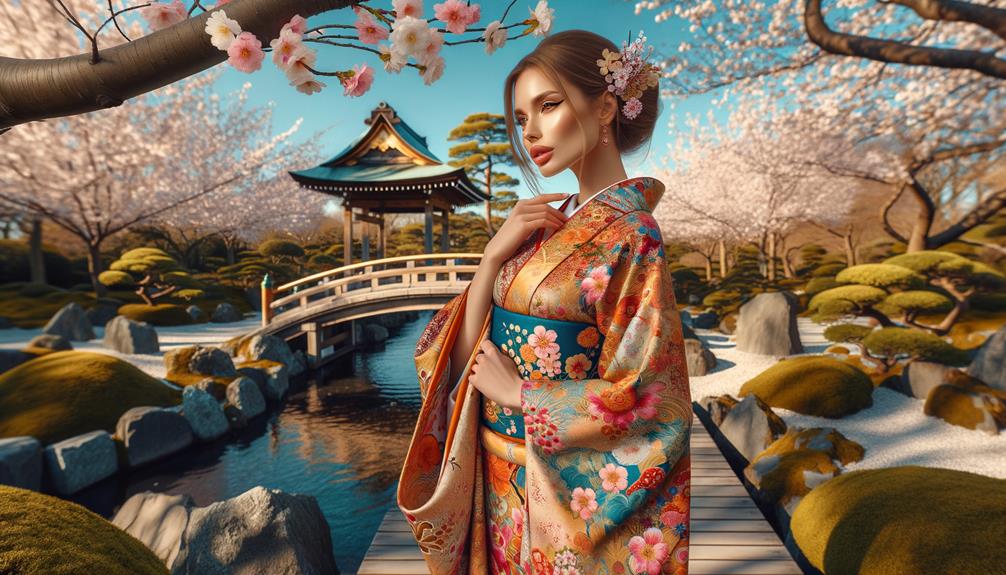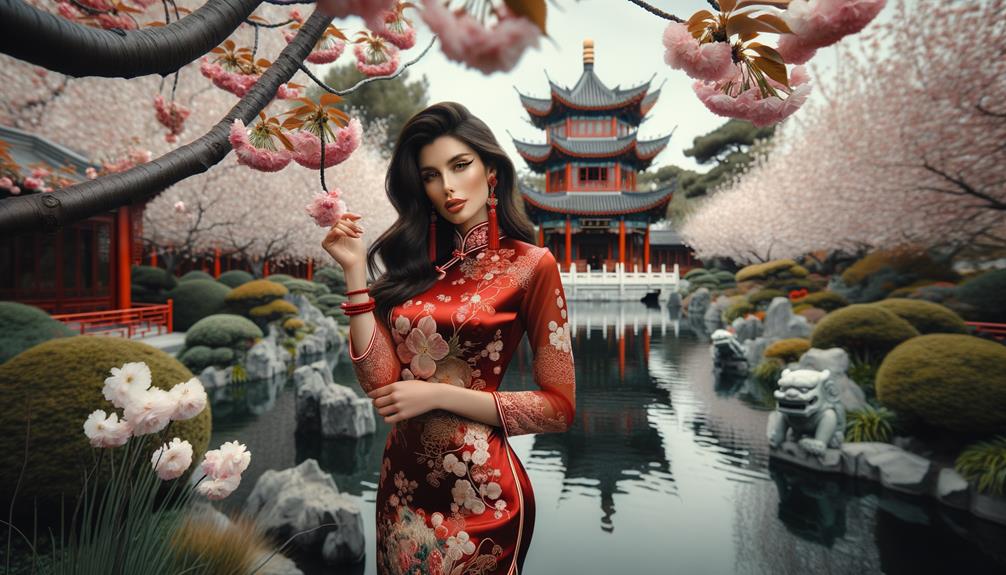When I think of the hanbok, I envision a kaleidoscope of vibrant colors and elegant lines, each hue infused with profound meaning. Red radiates passion, blue exudes serenity, yellow commands respect, and white whispers innocence. The luxurious fabrics of silk and satin elevate its timeless sophistication, while delicate accessories like norigae charms and binyeo hairpins add subtle beauty. Modern interpretations inject fresh vitality into this traditional attire, blending heritage with contemporary flair. Wearing a hanbok is not just about dressing up; it’s embracing a rich cultural legacy. Let’s delve deeper into its intricate charm and storied past.
History and Significance
Delving into the history and significance of hanbok, it’s striking how each vibrant color encapsulates the essence of Korean culture and its rich traditions. The traditional Korean dress is more than just fabric and thread; it’s a rich tapestry of meanings woven from the past. Hanbok colors aren’t chosen arbitrarily; they resonate deeply with Confucian principles and the social hierarchy that once dictated the lives of our ancestors.
Red represents passion and essentiality, reflecting the energy of life’s most significant moments. Blue, a calming hue, speaks to the soul’s need for peace. Yellow, often worn by royalty, radiates a sense of authority and respect. White symbolizes purity and innocence, a blank canvas of potential. Black, reserved for solemn occasions, adds a layer of gravity and reflection.
These colors also mirror the changing seasons – brighter tones for the rebirth of spring and summer, deeper shades for the introspection of fall and winter. Modern hanbok designers ingeniously blend these traditional elements with contemporary trends, creating a seamless fusion that honors the past while embracing the future. This vibrant palette isn’t just visually stunning; it’s a living, breathing chronicle of Korean heritage.
Elements of Hanbok
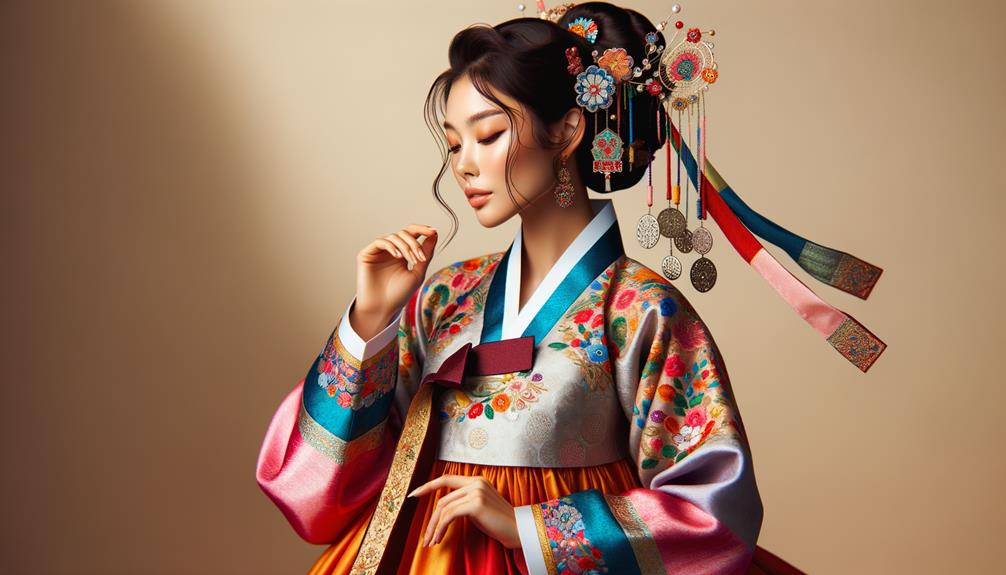
The intricate designs and vibrant hues of hanbok capture my imagination like a masterpiece on canvas. Each piece, from the elegant jeogori to the sweeping chima for women, and the jeogori paired with baji for men, speaks to a rich cultural heritage that continues to evolve. In modern interpretations, the hanbok becomes a dynamic fusion of tradition and innovation.
I’m particularly drawn to the incorporation of floral lace in modern hanbok designs. This delicate touch injects new life into the classic styles, blending the old with the new in a beautiful harmony. The intricate embroidery and symbolic patterns, including the revered five cardinal colors, remain, but are often reimagined to reflect contemporary aesthetics.
Silk, satin, and hemp fabrics exude elegance and cultural reverence, their textures inviting touch and admiration. Norigae, those exquisite decorative tassels, and binyeo, the ornate hairpins, are essential elements that complete the hanbok’s narrative.
The modern hanbok, with its innovative touches and floral lace, not only preserves history but reinterprets it, making each piece a wearable work of art that honors the past while embracing the future.
Color Symbolism
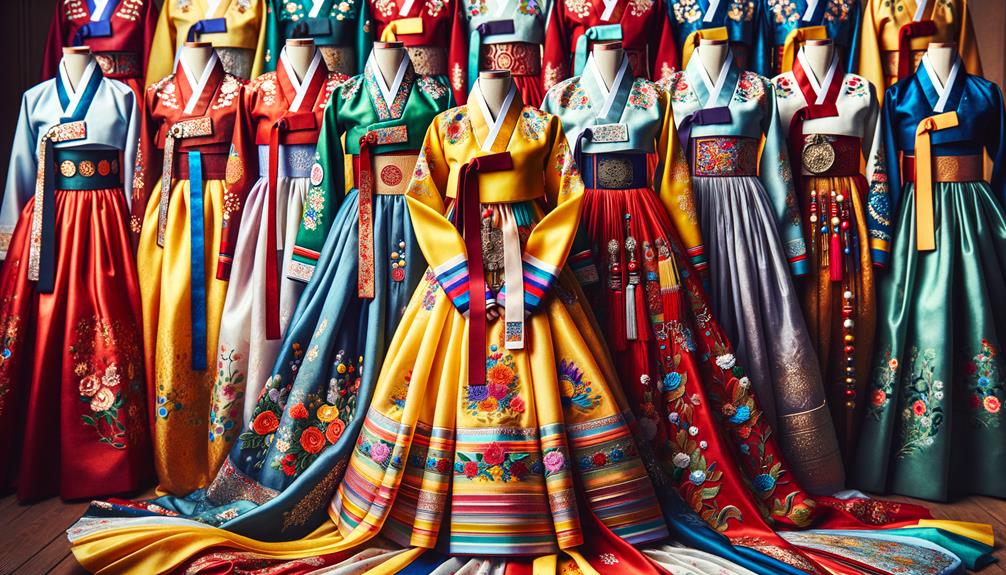
Among the vibrant hues of hanbok, each color tells a story, weaving a rich tapestry of symbolism that adds depth to the cultural narrative. In Korean culture, the colors chosen for hanbok are deliberate; they carry profound meanings that reveal the wearer’s intentions and status.
Red, often seen in wedding hanboks, symbolizes good fortune and happiness, radiating optimism and joy. Conversely, blue represents youth and fidelity, commonly worn by younger individuals to signify their vitality and loyalty. Yellow, reserved for royalty, embodies power and divine mandate, visually proclaiming authority and grandeur. White, the most revered color, stands for purity and integrity, reflecting the moral fabric of Korean culture.
The combinations of these colors aren’t just visually appealing; they convey subtle messages about social status, intentions, and occasion. Each hanbok is like a nuanced message, whispering secrets of tradition and identity. Understanding these color symbols adds a layer of depth, allowing us to appreciate the intricate beauty of Korean traditional attire. Hanbok isn’t just clothing; it’s a narrative woven into fabric and dye.
Modern Adaptations
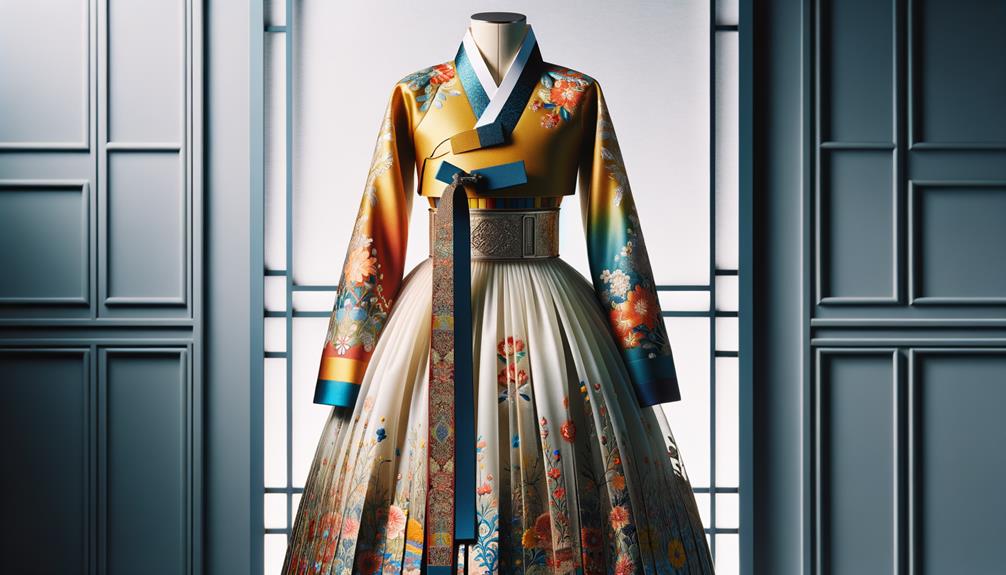
Embracing the essence of tradition while blending with modernity, the modern hanbok tells a story of timeless elegance merged with contemporary flair. Designers like Lee Young Hee have skillfully reimagined this attire, combining traditional hanbok elements with trendy styles and colors. The result is a captivating fusion of past and present.
I am struck by the innovative approaches to colors, patterns, and silhouettes that have transformed the look and feel of the modern hanbok. The use of modern fabrics ensures comfort and durability while honoring the rich heritage of this iconic dress. It’s fascinating to see how unique combinations of traditional hanbok details with modern designs create fresh perspectives and new stories.
Every thread and fold of the modern hanbok seems to whisper tales of the past while boldly stepping into the future. By reimagining the traditional hanbok, we’ve crafted an attire that resonates with the present and looks forward to the future, offering a harmonious blend of history and innovation. The modern hanbok stands as a testament to the enduring elegance and adaptability of Korean culture.
Wearing Hanbok
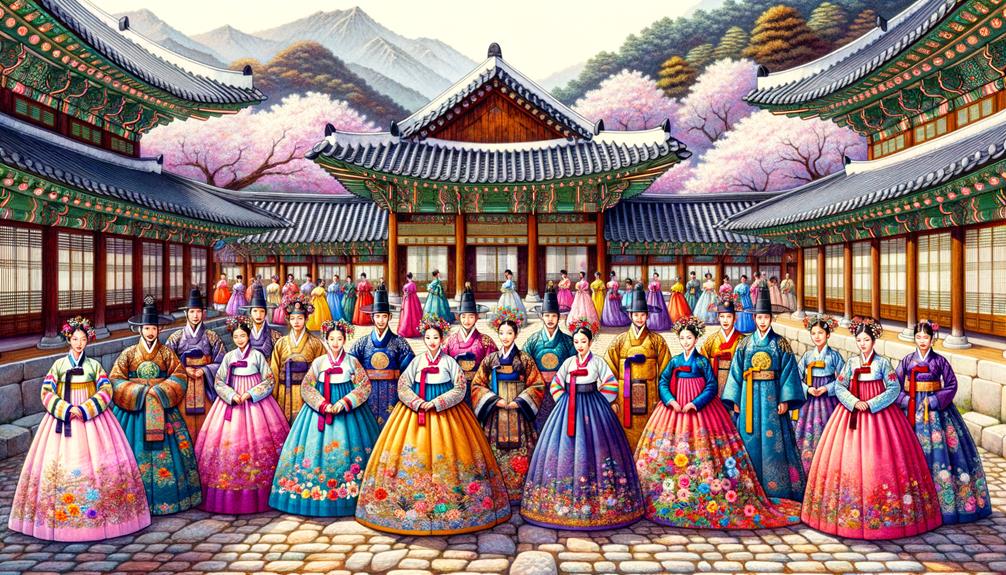
Wearing hanbok is like slipping into a rich tapestry of history and elegance. On traditional occasions, it shines with grandeur, while modern twists infuse it with fresh style. Accessorizing with hanbok becomes an art form, each piece telling a unique story.
Traditional Hanbok Occasions
In the heart of South Korea’s most cherished celebrations, the elegant hanbok embodies a deep respect for tradition and family. Wearing a traditional hanbok is not just about putting on a beautiful Korean dress; it’s about forming a meaningful connection with our cultural heritage. Each thread and pattern tells a story, a vibrant expression of our history.
During weddings, the hanbok’s intricate designs and vibrant hues reflect the joy and significance of the union. It’s not just attire, but a symbol of respect and continuity. At festivals like Seollal and Chuseok, wearing hanbok fosters a sense of belonging and togetherness, bridging generations through shared customs.
Ancestral rites see the hanbok in its most solemn form, symbolizing honor and remembrance. The choice of fabric, often dictated by the season, adds another layer of meaning. Silk for summer, wool for winter – each selection is a nod to practicality intertwined with tradition.
The hanbok’s colors and designs also convey information about the wearer’s social status and age, making it more than just clothing. It’s a narrative of who we are and where we come from, beautifully encapsulated in the folds of a traditional hanbok.
Modern Hanbok Trends
As we celebrate our heritage through traditional hanbok, I’m drawn to modern hanbok trends that masterfully merge the past with contemporary style. The evolution of the modern hanbok dress showcases Korean fashion’s creativity, transforming age-old designs with trendy cuts and innovative fabrics. This blend of tradition and modernity creates a captivating visual dance, allowing us to wear our cultural pride with a fresh spin.
Modern hanbok collections go beyond preserving history; they celebrate individuality. The versatility of these pieces is astounding, effortlessly shifting from casual outings to formal events. Picture a chic hanbok blouse paired with stylish trousers or a flowing hanbok skirt that exudes elegance at a dinner party. These are not mere garments; they tell a story that bridges the past and present.
The contemporary color palettes and stylish designs breathe new life into the hanbok, making it accessible and appealing to a broader audience. For those of us who appreciate both tradition and innovation, the modern hanbok dress is a canvas where heritage meets the future, painting a picture of timeless beauty.
Accessorizing With Hanbok
Accessorizing with hanbok allows me to weave my personal touch into a timeless tradition, creating a harmonious blend of elegance and self-expression. Each accessory I choose enriches the hanbok top and hanbok skirt, transforming the outfit into a canvas of my individuality. The Gwidorae Knot Tassel Belts add a touch of whimsy and tradition, while the Leesle Flower Daenggis lend an air of delicate beauty.
I find my artistic voice in the juxtaposition of modern and classic elements. Simple Durumagi Mufflers drape gracefully over my shoulders, contrasting the vibrant patterns of my hanbok skirt. The Maejukdo Girdle Waist Skirts and Willow Mother-of-pearl Girdle Waist Skirts accentuate my waist, creating a silhouette that’s both timeless and contemporary.
Accessories such as the King Taejo Eojin Ribbonpins and Goryeo Celadon Scrunchies infuse a regal touch, evoking historical grandeur. For a playful twist, I add Artificial Leather Tops and Phoenix Trackpants Shorts, bridging the gap between old and new. The Rope Chrysanthemum Knot Keyring Norigaes, hanging from my hanbok top, whisper stories of tradition with every sway.
Through accessorizing, I find a way to honor tradition while expressing my own voice, crafting a narrative that’s uniquely mine.
Where to Buy
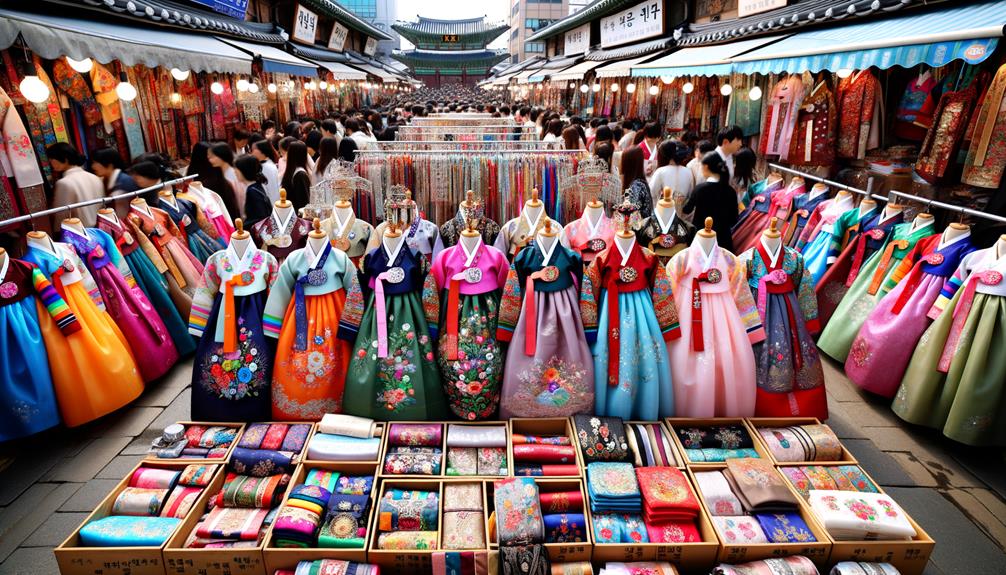
When I think of where to find a vibrant Hanbok, my mind wanders to Seoul’s lively streets and the ease of online shopping. Authentic Korean boutiques and modern brands like Joteta offer stunning pieces, while Etsy brings a charming, handmade touch. For those seeking a temporary experience, Seoul’s rental services provide the perfect opportunity.
Authentic Korean Boutiques
In the heart of Jeonju, I stumbled upon Joteta, a charming boutique that embodies the essence of Korean culture through its stunning hanbok dresses. As I entered, I was surrounded by a kaleidoscope of colors and intricate patterns, each piece telling a story of Korea’s rich heritage. Joteta’s modern hanbok designs masterfully blend traditional aesthetics with contemporary flair, offering a fresh take on the classic attire.
The boutique’s collection is a visual treat, featuring elegant and eye-catching pieces suitable for various occasions. Whether you’re attending a festival, a wedding, or simply want to experience Korean culture, Joteta’s hanbok dresses are sure to make a lasting impression. The attention to detail in each garment is remarkable, from the delicate embroidery to the vibrant hues that bring the fabric to life.
Exploring Joteta felt like stepping into Korea’s artistic soul. Each dress has a story to tell, weaving together threads of tradition and innovation. For those seeking a unique shopping experience that honors the past while embracing the present, authentic Korean boutiques like Joteta are a hidden gem waiting to be discovered.
Online Retail Platforms
Discovering the vibrant world of hanbok is just a click away, as online retail platforms like Etsy bring these colorful Korean dresses to your doorstep. With a simple search, you can uncover the allure of a Modern Hanbok Dress, featuring elegant lines and a contemporary flair that’s perfect for infusing your wardrobe with a touch of Korean heritage.
Etsy is a treasure trove of unique, handmade, and vintage Hanbok dresses, wrap skirts, and accessories. Each piece is imbued with the delicate craftsmanship of individual artisans. By supporting small businesses and creative entrepreneurs, every purchase contributes to a larger, global economy. Plus, many items qualify for free shipping, making it easy to explore these beautiful garments from anywhere.
When I think about the wrap skirts that flutter gracefully with every step, or the vibrant hues of a Modern Hanbok Dress, I’m reminded of the seamless blend of past and present. Etsy offers not just clothing, but a connection to a culture rich in history and artistry.
Rental Services Available
Rental Services Available
As I strolled through Seoul’s historic streets, I was drawn to the allure of traditional Korean dress, known as hanbok. The vibrant hues and graceful folds beckoned me to immerse myself in the timeless elegance of Korea’s rich cultural heritage. Hanbok rental services near Seoul’s historical sites offer a unique opportunity to explore landmarks while clad in history.
Each rental package includes a hanbok dress, a jacket, and accessories, ensuring a complete ensemble. The shops cater to diverse body types, offering a range of sizes for both men and women. Renting a hanbok is more than just dressing up – it’s about embracing a piece of Korean culture, feeling the fabric flow around your legs, and seeing the world through a historical lens.
Here’s a quick comparison of popular hanbok rental services:
| Rental Service | Location | Features |
|---|---|---|
| Hanboknam | Bukchon Hanok Village | Wide size range, group discounts |
| Oneday Hanbok | Gyeongbokgung Palace | Traditional and modern styles |
| Seohwa Hanbok | Changdeokgung Palace | Personalized fitting, premium fabrics |
| Hanbok Sarang | Insadong | Couple packages, free hair accessories |
| Coreano Hanbok | Namsangol Hanok Village | Full-day rentals, custom photo shoots |
This immersive experience transforms your visit, weaving you into the very fabric of Korean tradition.
Frequently Asked Questions
Do the Colors on a Hanbok Mean Anything?
The colors on a hanbok indeed hold meaning. I find it fascinating that red symbolizes passion, blue represents serenity, yellow is a sign of royalty, and white conveys purity. In modern designs, innovation has led to a broader palette of colors.
Is It Okay for Foreigners to Wear Hanbok?
Wearing a hanbok as a foreigner feels like stepping into Korea’s rich cultural heritage. The locals appreciate it, seeing it as a respectful nod to their traditions. It deepens my connection to the stories and history behind the garments.
Can Tourists Wear Hanbok in Korea?
I believe tourists can wear hanbok in Korea. It’s a beautiful way to immerse oneself in the culture. Renting a hanbok and wandering through historical sites offers an enchanting blend of tradition and personal exploration, deeply enriching.
What Does Hanbok Symbolize?
Hanbok embodies the essence of Korean heritage, blending tradition and artistry with effortless elegance. Each color tells a story, every stitch reflects tradition, and the overall design captures the soul of Korean identity, seamlessly merging culture and artistry.



